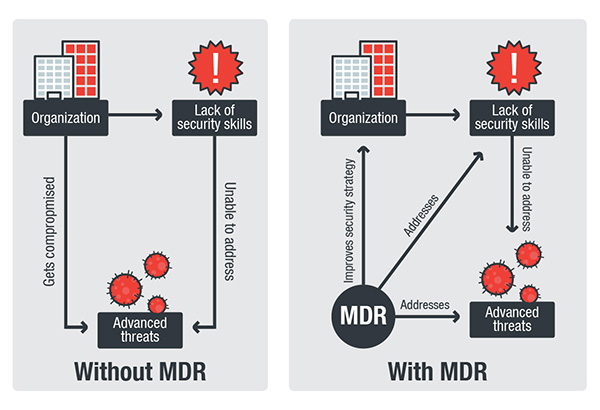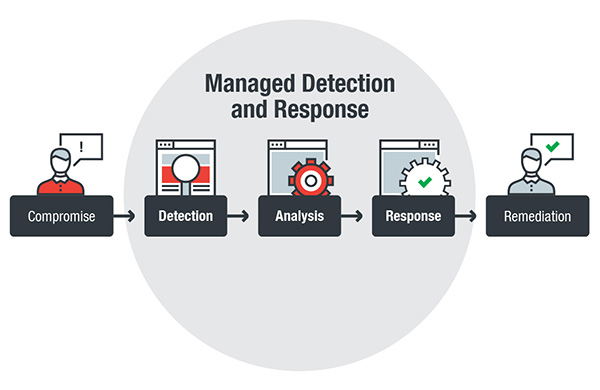Managed Detection and Response (MDR)
Managed detection and response is a
category of a Security-as-a-Service offering, where an organization outsources
some of its security operations to a third-party provider. As its name suggests,
it goes beyond simply detecting threats to actually working to remediate them on
an organization's network.
What is managed detection and
response?
Managed detection and response (MDR) is an outsourced service that provides
organizations with threat hunting services and responds to threats once they are
discovered. It also involves a human element: Security providers provide their
MDR customers access to their pool of security researchers and engineers, who
are responsible for monitoring networks, analyzing incidents, and responding to
security cases.
What challenges can MDR address?
MDR addresses significant problems that plague modern businesses. The most
glaring issue is a lack of security skills within organizations. While training
and setting up dedicated security teams that can do full-time threat hunting may
be feasible for larger organizations that can afford it, most companies will
find it a difficult proposition given their resource limitations. This is
especially true for medium and large organizations that often find themselves
being the target of cyberattacks but lack the resources or manpower for such
teams.
Even organizations that are willing
to spend both time and money might find it difficult to actually acquire the
right personnel. In 2016, there were 2 million unfilled cybersecurity positions,
a number that is expected to rise to 3.5 million by 2021.
Enterprises also face challenges
when deploying complex endpoint detection and response (EDR) solutions, which
are usually not being maximized due to a lack of time, skills, and funds to
train personnel to handle the EDR tools. MDR integrates EDR tools in its
security implementation, making them an integral part of the detection,
analysis, and response roles.
An often overlooked issue when it
comes to cybersecurity is the sheer volume of alerts security and IT teams
regularly receive. Many of these alerts cannot be readily identified as
malicious, and have to be checked on an individual basis. In addition, security
teams need to correlate these threats, since correlation can reveal whether
seemingly insignificant indicators all add up as part of a larger attack. This
can overwhelm smaller security teams, and take away precious time and resources
from their other tasks.
MDR aims to address this problem
not only by detecting threats but also by analyzing all the factors and
indicators involved in an alert. MDR also provides recommendations and changes
to the organizations based on the interpretation of the security events. One of
the most important skills that security professionals need is the ability to
contextualize and analyze indicators of compromise in order to better position
the company against future attacks. Security technologies may have the ability
to block threats, but digging deeper into the hows, whys, and whats of incidents
requires a human touch.
MDR is designed to solve the
problem of an organization’s cybersecurity skills gap. It tackles the issue of
more advanced threats that an in-house IT team cannot completely address,
ideally at a cost that is less than what the company will need to spend to build
its own specialized security team. MDR can also offer the organization access to
tools that it may not normally have access to. The diagram below illustrates
what an organization stands to gain when MDR comes into play.

How do MDR providers compare with MSSPs?
Organizations have traditionally turned to managed security service providers
(MSSPs) for their external security needs. In contrast with MDR providers, which
can detect lateral movement within a network, MSSPs typically work with
perimeter-based technology as well as rule-based detections to identify threats.
Also, the kinds of threats that MSSPs deal with are known threats, such as
vulnerability exploits, reoccurring malware, and high-volume attacks. MSSPs have
security professionals who perform log management, monitoring, and analysis, but
often not at a very in-depth level. In essence, MSSPs are able to manage an
organization’s security but typically only at the perimeter level, and their
analysis does not involve extensive forensics, threat research, and analytics.
In terms of service, MSSPs usually
communicate via email or phone, with security professionals as a secondary
access, while MDR providers carry out 24/7 continuous monitoring, which may not
be offered by some MSSPs.
However, MSSPs still provide value
to organizations. For example, managing firewalls and other day-to-day security
needs of an organization’s network is a task that is more apt for an MSSP than
an MDR provider, which offers a more specialized service. Accordingly, MSSPs and
MDR providers can work in conjunction with each other — with MDR providers
focusing on the proactive detection and behavioral analysis of more advanced
threats and giving remediation recommendations for organizations once the
threats are discovered.
How does Trend Micro’s MDR work?
Trend Micro’s MDR provides a wide array of security services, including alert
monitoring, alert prioritization, investigation, and threat hunting. It uses
artificial intelligence models and applies them to endpoint, network, and server
data in order to correlate and prioritize advanced threats. By investigating
prioritized alerts, Trend Micro threat researchers can then work with
organizations to provide a detailed remediation plan.
The diagram below shows the basic
process of how Trend Micro’s MDR responds to threats.

Detection
Trend Micro threat researchers continuously monitor an organization’s network
and endpoint data — performing threat sweeps to look for specific indicators of
compromise — and from there make decisions in terms of threat prioritization.
Analysis
Once a detected potential threat is correlated and prioritized, a team of
qualified security operations center (SOC) personnel investigate the origin and
scope of the attack, after which a detailed analysis of the threat and its
impact is determined.
Response
Trend Micro threat researchers will alert the organization of the incident, and
will also provide root cause analysis, mitigation recommendations, and toolkits
to help the organization handle the incident.

